Business
Cocoa, coffee and sugar climb charts, corn and orange juice unaffected
Due to the friendly weather, charts reflect an uphill trend for cocoa, coffee and sugar futures. Corn and orange juice remain unchanged since last week.

Wheat
Wheat markets were lower on Friday as forecasts for beneficial rains in the western Great Plains, mostly in Kansas for the first part of this week, were maintained. Forecasts still call for dry weather in Texas and Oklahoma.
The weekly export sales report was bad and added to the selling interest. In fact, demand has become a problem for this market, as the weekly export sales reports have been mostly subpar for many weeks. The demand needed to justify the ending stocks estimates from USDA is just not appearing, and there is some talk now that USDA will be forced to increase ending stocks estimates for the current crop in the next couple of monthly reports. US prices are too high when compared to the world competition.
Wheat futures are still in a weather market, and it remains very dry in the western Great Plains. La Nina conditions are still affecting the production potential for Hard Red Winter areas, but La Nina is fading, so chances for rains should start to improve. However, the systems keep missing the area and go to the north instead. A large part of the HRW crop is still rated in poor to a very poor condition as crops start to come out of dormancy. Minneapolis prices remain weaker in part on high Canadian production and in part on ideas of an increased planted area for Spring Wheat in the US this coming season. It was the strongest market yesterday but closed the week on a down note. Black Sea prices remain firm.
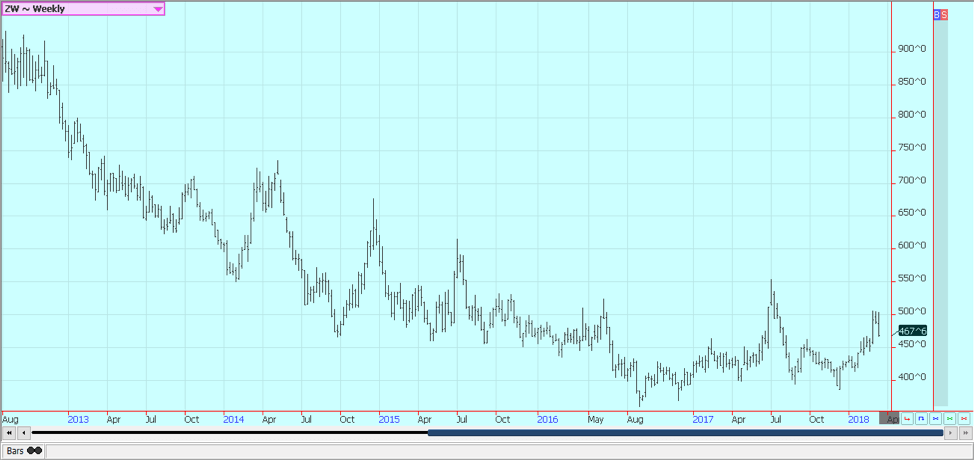
Weekly Chicago Soft Red Winter Wheat Futures © Jack Scoville

Weekly Chicago Hard Red Winter Wheat Futures © Jack Scoville
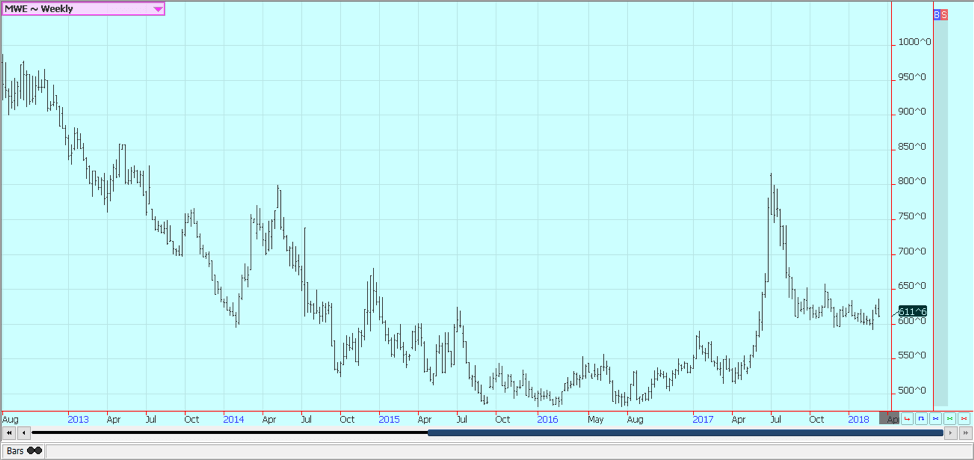
Weekly Minneapolis Hard Red Spring Wheat Futures © Jack Scoville
Corn
Corn closed about unchanged for the week as March went off the Board and May assumed the front-month position. Trends have turned down on the daily charts, but trends remain up on weekly charts. Oats saw selling pressure much of last week and trends are down in this market. Speculators have become very long in these markets and a corrective trade has begun.
USDA showed strong demand in its latest weekly export sales report. Export demand was the strongest for a week since 1994 and was the strongest ever for a nine-week period, according to Reuters. Corn remains a demand market, and the sales pace is still well above USDA projections for the marketing year.
Ethanol demand also remains very strong. The US Dollar still appears to be in a longer-term downtrend, but could be entering a short-term corrective phase that could hurt the export demand for a couple of weeks. More demand is expected due to the problems in South America due to the weather. Brazil is not offering Corn, while Argentina continues to struggle with dry weather problems of its own that are being caused by La Nina.
Argentina is expected to see some rains in production areas this week, but the rains might be coming too late to help the Corn and will be confined to northern areas. The bulk of the Argentine growing areas could stay dry Brazil is still too wet in central and northern areas to get the corn planted well and saw a lot of rain last week in southern parts of the country to interrupt harvest activities.
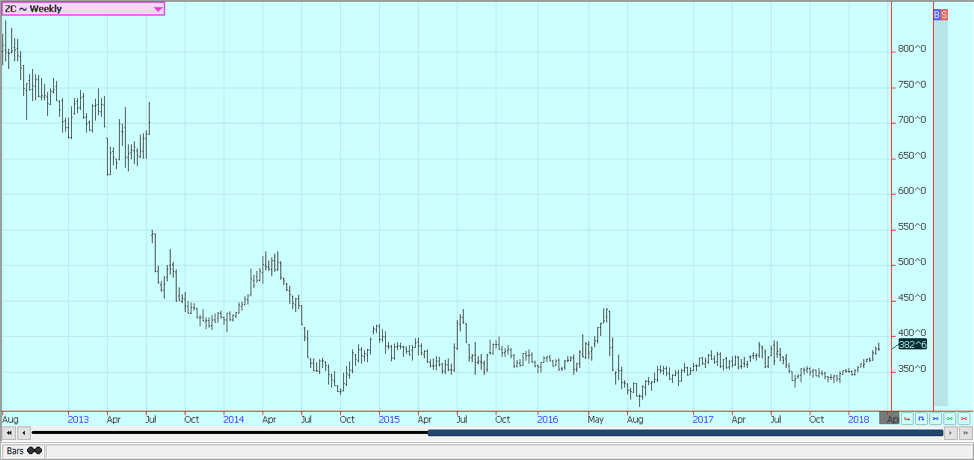
Weekly Corn Futures © Jack Scoville

Weekly Oats Futures © Jack Scoville
Soybeans and Soybean Meal
Soybeans and Soybean Meal were lower last week, with much of the selling seen because of changes in weather forecasts for this week in Argentina. USDA showed very strong export demand on Thursday. Futures prices remain supported due to high prices in South America that have come from the drought in Argentina. However, forecasts now call for some rain in Argentina this week. The rains will not cover many areas, but could provide some stability in areas where the rains do fall. The rains will not be enough to change the overall perspective of significant production losses for the country.
USDA noted big supplies from previous crops still in Argentina and Argentina will probably sell some of these older supplies. Some demand has finally started to shift to the US as Argentine cash market offers are very high priced and Brazil ports are operating at or near capacity already. The US is the new place to turn for Soybeans and products, and they are available and getting bought as the very strong export sales report showed last week. Stronger domestic demand has helped support Soybeans and Soybean Meal.

Weekly Chicago Soybeans Futures © Jack Scoville
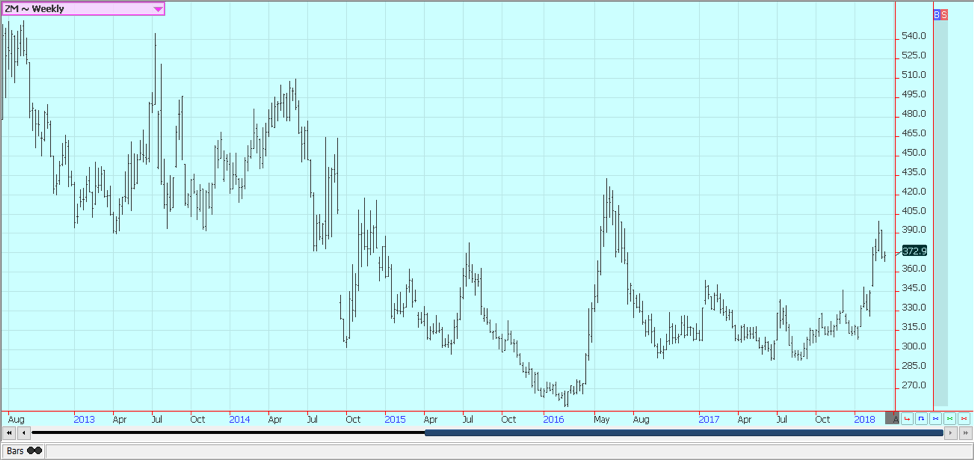
Weekly Chicago Soybean Meal Futures © Jack Scoville
Rice
Rice was higher on Friday and was higher for the week. Short-term trends have turned up, and weekly charts show that futures are testing some very important resistance areas. Moves higher this week could create some significant fund buying and short covering.
The US cash market bids remain generally strong amid tight supplies, but trading is reported to be quiet. Little is offered and mills are not really pushing the price higher, but higher prices are being paid. Reports indicate that Texas producers are about sold out for the marketing year.
Reports indicate that there is a limited amount of Rice still owned by farmers in the state, so commercials are raising bids to try to buy what is left. Limited amounts of Rice are reported to be owned by farmers in Louisiana and Mississippi as well. The amount of Rice still owned by farmers in Arkansas and Missouri is less clear, but the cash market indicates tight conditions. The focus is turning to the end of the month and the quarterly stocks reports and the prospective plantings reports.
The stocks on and off farm should be very low as indicated by the cash market. Prospective plantings should not show major increases in planted area as other crops are still more profitable to plant. Bankers in the Delta and Gulf Coast are more willing to finance Soybeans or Corn planting, and more Cotton could be planted as well. Planting of the next crop is underway now in Texas and east into Louisiana and Mississippi as weather permits. Drier weather for planting is desired. Most of these areas have seen significant rains in the last few weeks and soils are mostly too wet to plant right now.

Weekly Chicago Rice Futures © Jack Scoville
Palm Oil and Vegetable Oils
World vegetable oils prices were mixed to higher last week. The market sees big supplies of Palm Oil right now in both Indonesia and Malaysia and has big questions about demand. Palm Oil is effectively shut out of the Indian market for now, and buyers there are now looking to cancel purchases made earlier due to the tariffs. Demand from China remains a question market.
Many analysts now note the big Soybeans imports by China and think that China will have more than enough Soybean Oil produced from the imported Soybeans to cut import demand for all vegetable oils including Palm Oil. The trade is looking for Palm Oil production to continue to decrease in line with seasonal trends, and this expectation has provided the primary support.
The Malaysian Ringgit has been moving higher against the US Dollar, and this has firmed up prices for Palm Oil in the world market in Dollar terms. Canola markets remain mostly in up trends, but the market failed late last week. Deliveries to elevators have been strong due in part to forward selling earlier in the year, but new sales are hard to come by. US demand for Soybean Oil in bio fuels should remain strong, and stronger export demand is anticipated due to the threat of reduced production in Argentina. NOPA showed a very strong February crush rate last week, and stocks of Soybean Oil were higher than expected as a result.
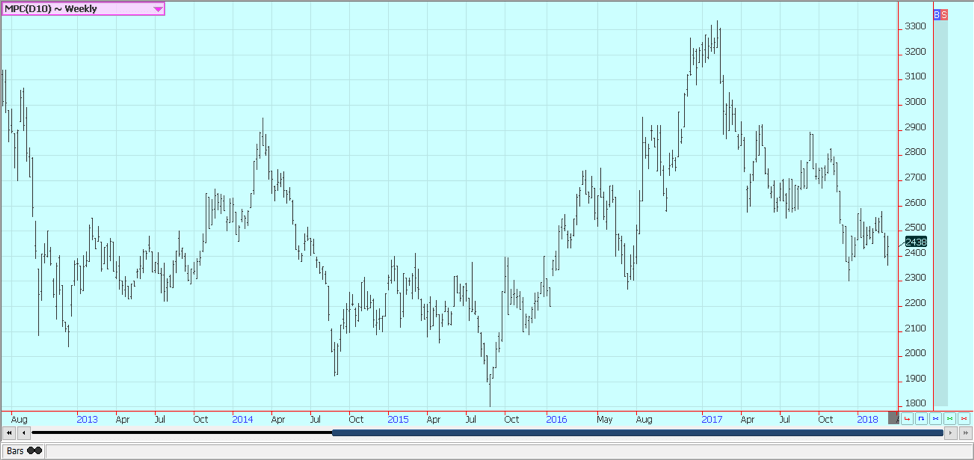
Weekly Malaysian Palm Oil Futures © Jack Scoville
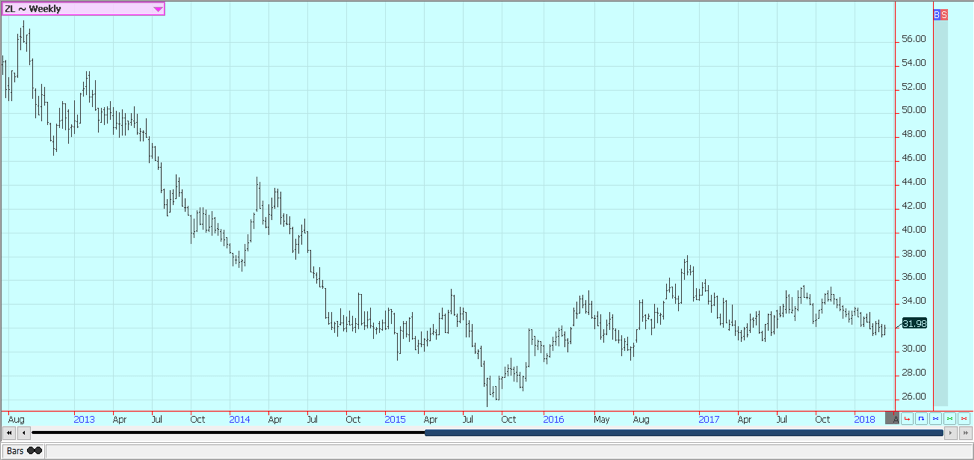
Weekly Chicago Soybean Oil Futures © Jack Scoville
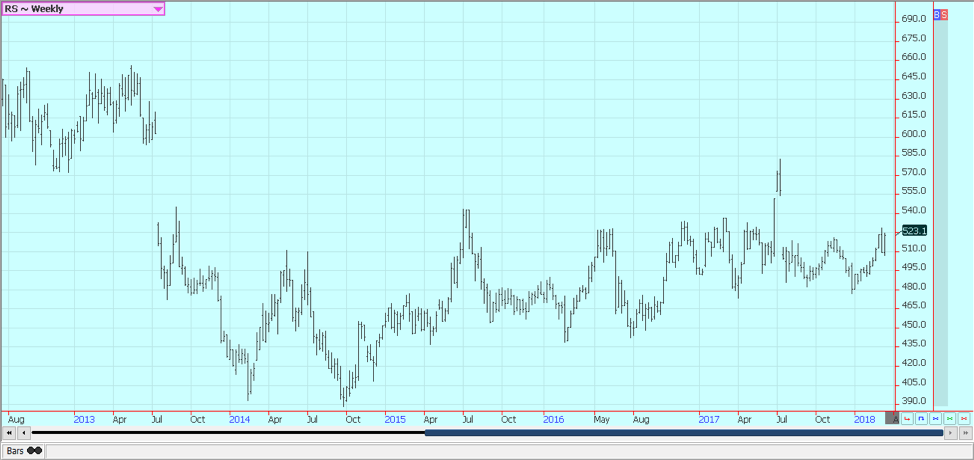
Weekly Canola Futures © Jack Scoville
Cotton
Cotton was lower. The weekly charts show that futures has so far failed against some big down trend lines, so the market is entering an important period. It made a new low for the correction before showing a little recovery. The weekly export sales report was very strong once again. Demand remains strong and merchants have had trouble finding the Cotton in domestic cash markets. Prices overall have been much higher than most commercials had expected, and they remain heavily short the market, with funds and index funds taking the other side. Prices could remain strong until closer to harvest due to tight domestic markets. There have also been quality concerns left over from the hurricanes and the freeze during the growing season.
USDA expects demand to remain very strong. The trade will also look for ideas of plantings as the Spring is starting now in many production areas. Plantings could be higher than USDA projections due to the big problems with the Winter Wheat crops in the western Great Plains. Some rain is forecast for Kansas this week that could improve crop prospects for Winter Wheat and reduce prospective plantings by a little bit.
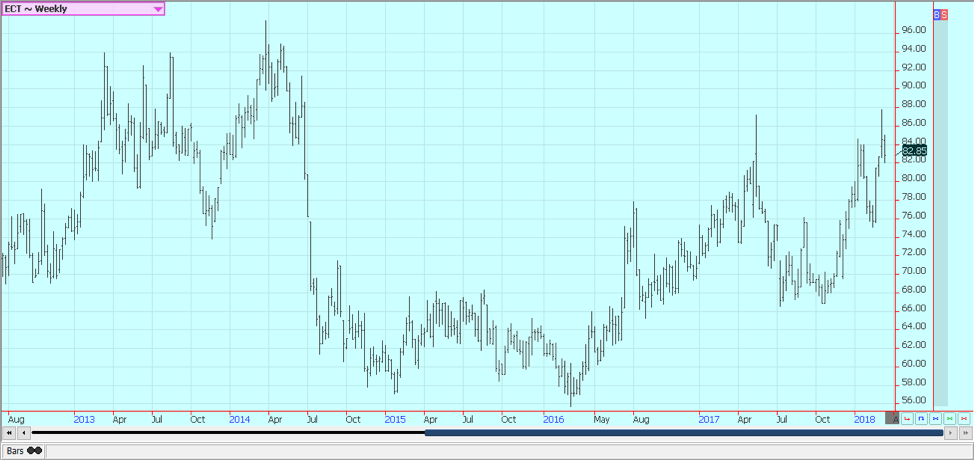
Weekly US Cotton Futures © Jack Scoville
Frozen Concentrated Orange Juice and Citrus
FCOJ was a little lower last week. Futures remain in a trading range but show a weak appearance on both the daily and weekly charts and Florida remain mostly warm and dry. The market is still dealing with a short crop against weak demand. USDA estimated the crop at about 45 million boxes in its last report. The current weather is good as temperatures are warm and it is mostly dry, but the crop is small. The harvest is progressing well and fruit is being delivered to processors and the fresh fruit packers. Trees in Florida are showing fruit of good sizes, and producers are now into the Valencia crop with the early and mid harvest completed. Florida producers are actively harvesting and performing maintenance on land and trees. Some early flowering has been reported in the groves, and some fruit is forming. Irrigation is being used.

Weekly FCOJ Futures © Jack Scoville
Coffee
Futures were lower on Friday and a little lower for the week in New York. London was slightly higher on Friday. London was lower for the week. Both markets are looking for news to cause a move in either direction. The charts present a sideways appearance for now in New York and speculators remain very short. London charts are showing a sustained uptrend, but futures are now moving to test the up trend line this week. Traders anticipate big crops from Brazil and from Vietnam this year and have seen no reason to cover the short position in a big way.
New York traders are talking about good weather currently being reported in Brazil and expect another bumper crop. There were reports from London of increased Vietnamese selling, and Robusta is now more available. These reports are not being backed by the price action, and Robusta remains the stronger market. The situation seems little changed in Latin America. There are reports of short crops in parts of Central America and some areas in South America due to the lack of farmer investment from the low prices. Honduras has been a very active exporter and offers from most other countries are seen. Differentials in Central America are low and the buy side is quiet.
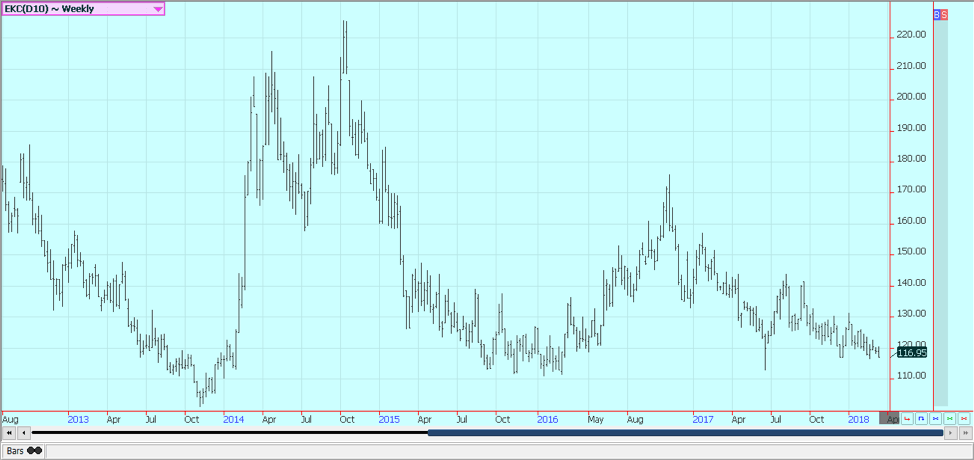
Weekly New York Arabica Coffee Futures © Jack Scoville
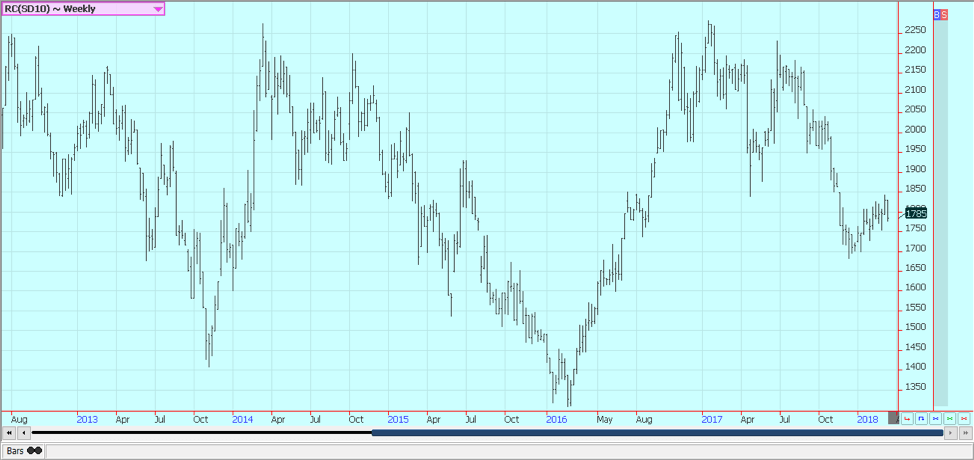
Weekly London Robusta Coffee Futures © Jack Scoville
Sugar
Futures were lower for the week. Trends are down again in both markets and both markets are making new contract lows. The overall feel of the market is that prices for now are cheap enough, but both New York and London appear to need a catalyst to work higher in a big way. Ideas that Sugar supplies available to the market can increase in the short term have been key to the selling. India will export up to 4.0 million tons of Sugar this year after being a net importer for the last couple of years. Thailand has produced a record crop and is selling. Mills in Brazil have decided to make more Ethanol as world Crude Oil and products prices have been very strong. Brazil still has plenty of Sugar to sell even with the different refining mix. The ISO expects production to outstrip demand by more than 5 million tons this year as the market recovers from a 2.5 million tons production deficit last year.
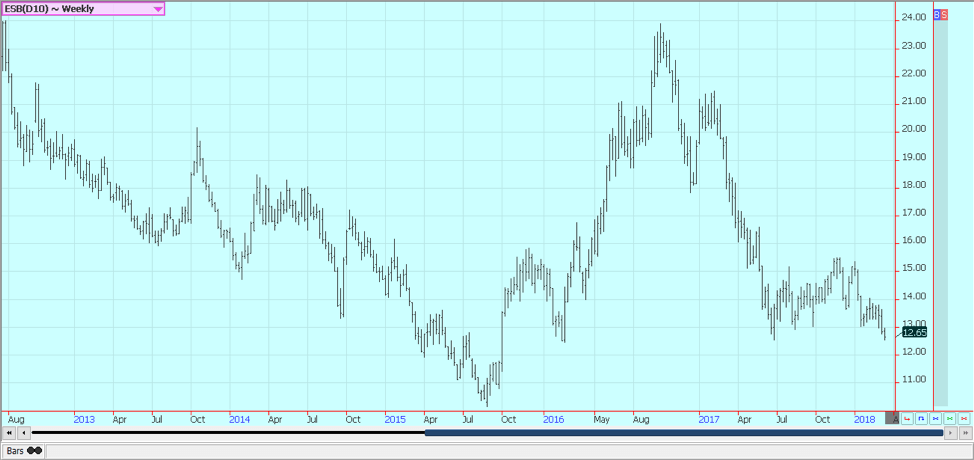
Weekly New York World Raw Sugar Futures © Jack Scoville
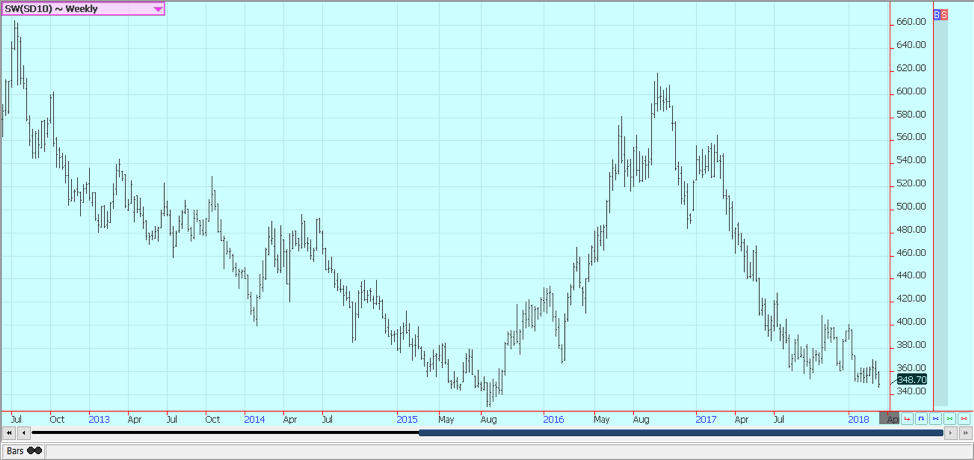
Weekly London White Sugar Futures © Jack Scoville
Cocoa
Futures were higher for the week. Trends are up in both markets on the daily and weekly charts. It has been hot and dry in many parts of West Africa, so conditions are good for the winds to form. Some crop losses might be possible if the current conditions persist. There have been reports of some showers in West Africa, so perhaps the season is changing now. The gut slot for offers from the main crop is passing, and the sales by the government suggest that offers down the road can be less. The mid crop harvest is starting in some areas. The recent grind data was weaker for North America, but positive for Europe and Asia. Demand is not universally strong, but has been improving and is likely to continue to improve as long as prices stay generally weak as processing margins are said to be very strong.
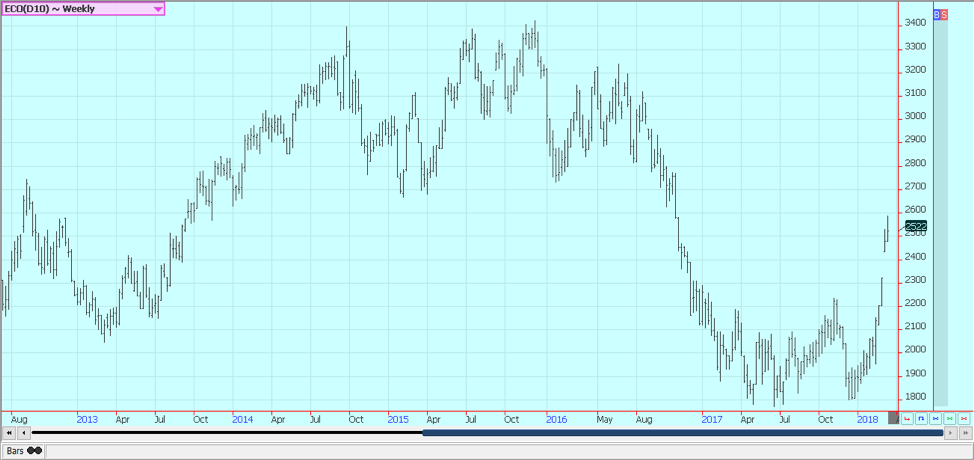
Weekly New York Cocoa Futures © Jack Scoville

Weekly London Cocoa Futures © Jack Scoville
Futures and options trading involves substantial risk of loss and may not be suitable for everyone. The valuation of futures and options may fluctuate and as a result, clients may lose more than their original investment. In no event should the content of this website be construed as an express or implied promise, guarantee, or implication by or from The PRICE Futures Group, Inc. that you will profit or that losses can or will be limited whatsoever. Past performance is not indicative of future results. Information provided on this report is intended solely for informative purpose and is obtained from sources believed to be reliable. No guarantee of any kind is implied or possible where projections of future conditions are attempted.
The leverage created by trading on margin can work against you as well as for you, and losses can exceed your entire investment. Before opening an account and trading, you should seek advice from your advisors as appropriate to ensure that you understand the risks and can withstand the losses.
_
DISCLAIMER: This article expresses my own ideas and opinions. Any information I have shared are from sources that I believe to be reliable and accurate. I did not receive any financial compensation in writing this post, nor do I own any shares in any company I’ve mentioned. I encourage any reader to do their own diligent research first before making any investment decisions.

-

 Cannabis3 days ago
Cannabis3 days agoCannabis Company Adopts Dogecoin for Treasury Innovation
-

 Biotech1 week ago
Biotech1 week agoPfizer Spain Highlights Innovation and Impact in 2024 Report Amid Key Anniversaries
-

 Markets5 days ago
Markets5 days agoStock Markets Surge Amid Global Uncertainty, But Storm Clouds Loom
-

 Africa2 days ago
Africa2 days agoMorocco Charts a Citizen-Centered Path for Ethical and Inclusive AI
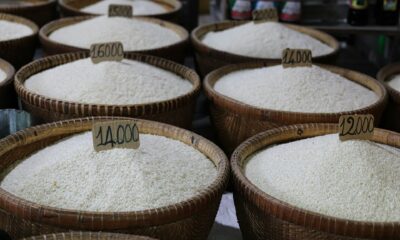

























You must be logged in to post a comment Login